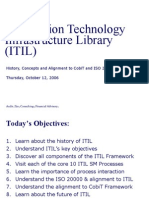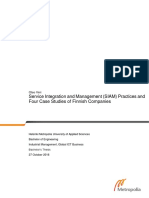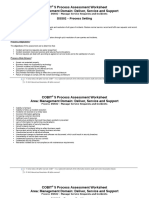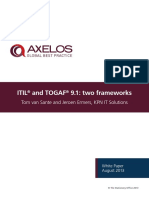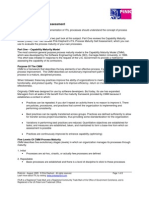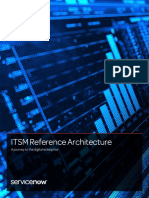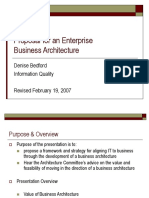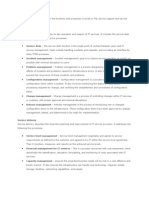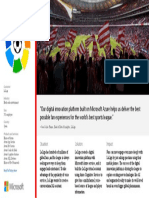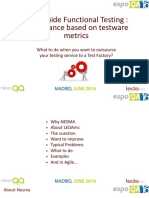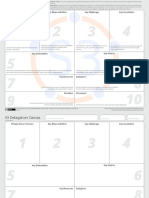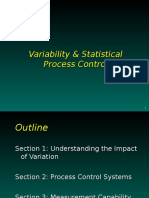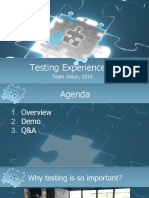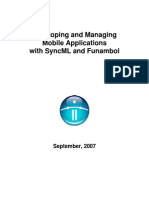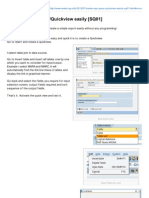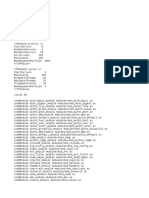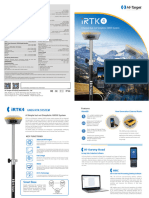Definitions and Symbols: Functional Component (Primary) Key Data Object
Definitions and Symbols: Functional Component (Primary) Key Data Object
Uploaded by
Luis Alberto Lamas LavinCopyright:
Available Formats
Definitions and Symbols: Functional Component (Primary) Key Data Object
Definitions and Symbols: Functional Component (Primary) Key Data Object
Uploaded by
Luis Alberto Lamas LavinOriginal Description:
Original Title
Copyright
Available Formats
Share this document
Did you find this document useful?
Is this content inappropriate?
Copyright:
Available Formats
Definitions and Symbols: Functional Component (Primary) Key Data Object
Definitions and Symbols: Functional Component (Primary) Key Data Object
Uploaded by
Luis Alberto Lamas LavinCopyright:
Available Formats
Definitions and Symbols
Information Model
Functional Model
Object Type
Description
Key Data Object
Key data objects describe aspects of
how services are created, delivered, and
consumed; they are essential to managing
the service lifecycle. Managing the endto-end service lifecycle and associated
measurement, reporting, and traceability
would be virtually impossible without them.
The IT4IT Reference Architecture defines 32
key data objects and most are depicted as
black circles.
Service Model
Auxiliary Data
Object
Service models are a stand-alone subclass
of key data objects that describe what IT
delivers to its consumers. They represent
the attributes of a service at three levels
of abstraction: Conceptual, Logical, and
Realized. These data objects are referred to
as Service Model Backbone data objects (or
service backbone data objects in short form)
and depicted using a purple colored circle in
the IT4IT Reference Architecture diagrams.
Auxiliary data objects provide context for
the why, when, where, etc. attributes and,
while they are important to the IT function,
they do not play a vital role in managing
the service lifecycle. The IT4IT Reference
Architecture currently describes eight (8)
auxiliary data objects and they are depicted
using a gray colored circle.
Informal
Representation
Formal
Representation
Object Type
Description
Primary
Functional
Component
A primary functional component is depicted
using a blue colored rectangle and is core
to a specific value stream. This means that
the functional component plays a key role
in the activities of a particular value stream.
Without this functional component, the
integrity of the data objects and thus the
Service Model could not be maintained
consistently and efficiently. Most IT4IT
documentation will use language such as a
functional component is owned by or is core
to a particular value stream to represent a
primary functional component.
Data Object
Key Data
Object
Data Object
Service Model
Secondary
Functional
Component
Data Object
Auxiliary Data
Object
www.orbussoftware.com
Secondary functional components are
depicted using a gray colored rectangle
and represent some level of dependency
or interaction with a value stream and its
data objects. While they interact with a
value stream, they are not core to it and are
either primary to another value stream or
supporting function or represent a capability
Informal
Representation
Functional
Component (Primary)
Functional Component
(Secondary)
Formal
Representation
Application
Component
Application
Component
Definitions and Symbols
Information Model
Relationship Type
Entity
Relationship
Description
Informal
Representation
Formal
Representation
The essential relationships between data objects
within and across value streams are defined
in the IT4IT Reference Architecture. These
relationships function as a prescriptive guide for
ensuring the integrity of the Service Model as
it progresses through its lifecycle and facilitate
traceability across value streams. Within the
IT4IT Reference Architecture, the relationship
between data objects is annotated as follows:
1:1
1 to 1 (1:1): implies that if there is a relationship, it is between
two data objects. It does not imply that there will always
be a relationship. For example, Events without Incidents or
Incidents without Events are legitimate scenarios.
1:1
0..1:0..1
1 to many (1:n): implies that one data object relates (A) to
one or more other data objects (B...) in scenarios where
there is a relationship.
1:n
0..1:*
Many to many (n:m): implies that both and A and B above can
relate to zero, one, or many of the connected data objects.
n:m
*..*:*
Record Fabric
Relationship
These entity relationship definitions
ensure the consistent management of the
lifecycle for individual data objects, as
well as ensuring that the data objects are
consistently named and crosslinked through
prescriptive data flows between functional
components to maintain the integrity of the
Service Model. They are represented by a
dotted black line.
Engagement
Dataflow
These are user interface integrations derived
from value stream use-cases and user stories.
These integrations deliver the technology
underpinning for a capability by combining
several functional components into a
single user experience to facilitate human
interaction with data objects. In the IT4IT
Reference Architecture system of engagement
integrations are represented by the blue arrow
0..1
0..1
www.orbussoftware.com
You might also like
- Basic Computer Quiz Questions With AnswersDocument3 pagesBasic Computer Quiz Questions With AnswersRimpa Dey83% (12)
- Measuring Itsm: Measuring, Reporting, and Modeling the It Service Management Metrics That Matter Most to It Senior ExecutivesFrom EverandMeasuring Itsm: Measuring, Reporting, and Modeling the It Service Management Metrics That Matter Most to It Senior ExecutivesNo ratings yet
- Servicing Itsm: A Handbook of Service Descriptions for It Service Managers and a Means for Building ThemFrom EverandServicing Itsm: A Handbook of Service Descriptions for It Service Managers and a Means for Building ThemRating: 4 out of 5 stars4/5 (2)
- Service Catalog TemplateDocument15 pagesService Catalog TemplateHello Word :-)100% (2)
- ITIL Implementation Guide PDFDocument36 pagesITIL Implementation Guide PDFracringandhi100% (1)
- Business Battle MappingDocument11 pagesBusiness Battle MappingHenrik Mårtensson100% (2)
- Architecting Itsm: A Reference of Configuration Items and Building Blocks for a Comprehensive It Service Management InfrastructureFrom EverandArchitecting Itsm: A Reference of Configuration Items and Building Blocks for a Comprehensive It Service Management InfrastructureNo ratings yet
- 1 Service Integration Management (SIAM) Service Descriptions V8a PDFDocument56 pages1 Service Integration Management (SIAM) Service Descriptions V8a PDFsean100% (1)
- ITIL Process Maturity FrameworkDocument2 pagesITIL Process Maturity FrameworkpdsramaraoNo ratings yet
- Insyde Bios ManualDocument2 pagesInsyde Bios Manualphoenixkingtt0% (1)
- IT4IT Levels 1 & 2 PosterDocument1 pageIT4IT Levels 1 & 2 PosterLuis Alberto Lamas LavinNo ratings yet
- ITIL - Service Validation and TestingDocument17 pagesITIL - Service Validation and TestingFederico MarzulloNo ratings yet
- ITIL Process Maturity Assessment and Roadmap v5Document38 pagesITIL Process Maturity Assessment and Roadmap v5danrodd100% (4)
- ITservice Management Maturity Assessment ModelDocument15 pagesITservice Management Maturity Assessment Modelscripduser1973100% (1)
- Who Is The King of SIAM?: Simon Dorst, Michelle Major-Goldsmith, Steve RobinsonDocument19 pagesWho Is The King of SIAM?: Simon Dorst, Michelle Major-Goldsmith, Steve RobinsonEugene ArkadievNo ratings yet
- SPUSC-Service Management and Delivery - Steve BittingerDocument25 pagesSPUSC-Service Management and Delivery - Steve Bittingervarsiva1827No ratings yet
- List Price Portal - 06.18.2020 - v2Document26 pagesList Price Portal - 06.18.2020 - v2Luis Alberto Lamas LavinNo ratings yet
- IT4IT Levels 1 & 2 PosterDocument1 pageIT4IT Levels 1 & 2 PosterLuis Alberto Lamas LavinNo ratings yet
- High Velocity Itsm: Agile It Service Management for Rapid Change in a World of Devops, Lean It and Cloud ComputingFrom EverandHigh Velocity Itsm: Agile It Service Management for Rapid Change in a World of Devops, Lean It and Cloud ComputingNo ratings yet
- Implementing Itsm: From Silos to Services: Transforming the It Organization to an It Service Management Valued PartnerFrom EverandImplementing Itsm: From Silos to Services: Transforming the It Organization to an It Service Management Valued PartnerNo ratings yet
- Organizing Itsm: Transitioning the It Organization from Silos to Services with Practical Organizational ChangeFrom EverandOrganizing Itsm: Transitioning the It Organization from Silos to Services with Practical Organizational ChangeNo ratings yet
- Material de Referencia - IT4IT Reference CardsDocument10 pagesMaterial de Referencia - IT4IT Reference Cardsdagomez2013No ratings yet
- IT4IT Reference Card1Document1 pageIT4IT Reference Card1GuillermoVillalonNo ratings yet
- Information Technology Infrastructure Library (ITIL)Document65 pagesInformation Technology Infrastructure Library (ITIL)Wong Chan WengNo ratings yet
- How To Get Started With IT4ITDocument156 pagesHow To Get Started With IT4ITerlend2012100% (1)
- BMC - Maturity Models For ITIL Processes and FunctionsDocument4 pagesBMC - Maturity Models For ITIL Processes and FunctionsRoy YangNo ratings yet
- R2F: Request To Fulfill: Manage Catalog, Subscriptions, and Fulfillment Across Multiple ProvidersDocument1 pageR2F: Request To Fulfill: Manage Catalog, Subscriptions, and Fulfillment Across Multiple ProvidersGuillermoVillalonNo ratings yet
- Agile and IT4ITDocument67 pagesAgile and IT4ITLuis Alberto Lamas Lavin100% (2)
- 03 Derek Gillard - Service Catalogue JourneyDocument28 pages03 Derek Gillard - Service Catalogue Journeyarsman1100% (1)
- Process To PraticesDocument3 pagesProcess To PraticesAndrea GiulianiNo ratings yet
- Rri - Service Integration and Management SIAM Practices and Four Case Studies of Finnish Companies PDFDocument88 pagesRri - Service Integration and Management SIAM Practices and Four Case Studies of Finnish Companies PDFOmkar YadavNo ratings yet
- ITSM Service CatalogDocument5 pagesITSM Service CatalogJirawat WonglamNo ratings yet
- A Starter Set of ITSM Guiding PrinciplesDocument96 pagesA Starter Set of ITSM Guiding PrinciplesalawawdsNo ratings yet
- How To Scope Your Enterprise CMDB Project Successfully: Big Vision, Baby StepsDocument31 pagesHow To Scope Your Enterprise CMDB Project Successfully: Big Vision, Baby StepsgamezzzzNo ratings yet
- Maxtrade Inc: It Strategy-Assignment 4Document13 pagesMaxtrade Inc: It Strategy-Assignment 4prep100No ratings yet
- IT Service Management Implementation OverviewDocument60 pagesIT Service Management Implementation OverviewAlan McSweeney100% (1)
- Roles With ITIL v3Document9 pagesRoles With ITIL v3Pratul SharmaNo ratings yet
- Process Improvement Calculations ToolsDocument65 pagesProcess Improvement Calculations ToolsNevets Nonnac100% (1)
- It 4 ItDocument75 pagesIt 4 Itserviocuevas50% (2)
- ITOM Process Reference Model (All Attributes)Document1 pageITOM Process Reference Model (All Attributes)aboix253100% (1)
- DSS02 Manage Service Requests and IncidentsDocument14 pagesDSS02 Manage Service Requests and Incidentsnyamsuren.mncertNo ratings yet
- 3-ITIL V3 OverviewDocument52 pages3-ITIL V3 OverviewRatheesh Kumar100% (1)
- AXELOS SIAM WhitepaperDocument24 pagesAXELOS SIAM WhitepaperSurya Prakash Garg100% (1)
- Togaf&itil PDFDocument12 pagesTogaf&itil PDFpolen chheangNo ratings yet
- ITIL Process MaturityDocument8 pagesITIL Process Maturitymariela-collado-3485100% (1)
- Implementing A Service Catalog - 5 Top Tips by Sharon TaylorDocument14 pagesImplementing A Service Catalog - 5 Top Tips by Sharon TaylorAxiosSystems100% (1)
- ITSM Reference Architecture v1 PDFDocument42 pagesITSM Reference Architecture v1 PDFvenky95100% (2)
- BMC - Service Portfolio Management WhitepaperDocument10 pagesBMC - Service Portfolio Management WhitepaperRoss ManningNo ratings yet
- Final Business Architecture Presentation - v1 0Document36 pagesFinal Business Architecture Presentation - v1 0haji5No ratings yet
- Itil Cobit Iso20000 Alignment IsacaDocument65 pagesItil Cobit Iso20000 Alignment IsacaMolderXNo ratings yet
- Implementing ITILDocument27 pagesImplementing ITILvimpat100% (3)
- ITSM - Whitepaper - Asset MGMTDocument143 pagesITSM - Whitepaper - Asset MGMTKaiNo ratings yet
- Implementation of Service Integration in A Multiprovider Environment Using COBIT 5Document9 pagesImplementation of Service Integration in A Multiprovider Environment Using COBIT 5hdoornboNo ratings yet
- Global Best Practice Standard For Service Desk V8.2.2019.07Document95 pagesGlobal Best Practice Standard For Service Desk V8.2.2019.07Enrique Freyre100% (1)
- CIO HandbookDocument112 pagesCIO HandbookIgor BrodinNo ratings yet
- Measures and Metrics (Study Guide)Document29 pagesMeasures and Metrics (Study Guide)Eduardo MucajiNo ratings yet
- ITIL Service Support and Service DeliveryDocument2 pagesITIL Service Support and Service DeliveryhyrtksnNo ratings yet
- Itsm Process Maps Whitepaper 6.08 WebDocument20 pagesItsm Process Maps Whitepaper 6.08 Webrohit.joshi4u100% (2)
- Be An IT Services Broker: HP Service Integration and ManagementDocument15 pagesBe An IT Services Broker: HP Service Integration and ManagementRamón AlonsoNo ratings yet
- It4it Webinar 01Document14 pagesIt4it Webinar 01GerardobalbinoNo ratings yet
- IT4IT Reference Card4Document1 pageIT4IT Reference Card4GuillermoVillalonNo ratings yet
- ITIL DeliveryDocument74 pagesITIL Deliverygautata100% (1)
- ITIL Service Transition - Invensis LearningDocument21 pagesITIL Service Transition - Invensis LearningInvensislearningNo ratings yet
- Laliga Summary SlideDocument1 pageLaliga Summary SlideLuis Alberto Lamas LavinNo ratings yet
- Features and Character Classifier: The Components That Made Tesseract SuccessfulDocument29 pagesFeatures and Character Classifier: The Components That Made Tesseract SuccessfulLuis Alberto Lamas LavinNo ratings yet
- ExpoQA16 Ignacio Ton LedamcDocument22 pagesExpoQA16 Ignacio Ton LedamcLuis Alberto Lamas LavinNo ratings yet
- Scrum Your Jira! - Your Waterfall Organization Transfomed Into Agile Multidisciplinary Teams - Clemens LodeDocument91 pagesScrum Your Jira! - Your Waterfall Organization Transfomed Into Agile Multidisciplinary Teams - Clemens LodeLuis Alberto Lamas Lavin100% (1)
- Pizza Oven: Baking Time: 30 S Capacity: 1-3 SlicesDocument1 pagePizza Oven: Baking Time: 30 S Capacity: 1-3 SlicesLuis Alberto Lamas LavinNo ratings yet
- s3 Delegation CanvasDocument2 pagess3 Delegation CanvasLuis Alberto Lamas LavinNo ratings yet
- En Business Rules 2013 20130814Document39 pagesEn Business Rules 2013 20130814Luis Alberto Lamas LavinNo ratings yet
- En Field Constraints 2013 20130801Document8 pagesEn Field Constraints 2013 20130801Luis Alberto Lamas LavinNo ratings yet
- En-History of Changes 2013-20130812Document32 pagesEn-History of Changes 2013-20130812Luis Alberto Lamas LavinNo ratings yet
- En Domain Management 2013 20130809Document15 pagesEn Domain Management 2013 20130809Luis Alberto Lamas LavinNo ratings yet
- IT4IT AcceleratorDocument2 pagesIT4IT AcceleratorLuis Alberto Lamas LavinNo ratings yet
- 6 Change Approaches: Framework PrimerDocument20 pages6 Change Approaches: Framework PrimerLuis Alberto Lamas LavinNo ratings yet
- EASYVISTA Extending SSO Security Exchanges With EasyVistaDocument11 pagesEASYVISTA Extending SSO Security Exchanges With EasyVistaLuis Alberto Lamas LavinNo ratings yet
- SPC Tutorial SIADocument88 pagesSPC Tutorial SIALuis Alberto Lamas LavinNo ratings yet
- BPM Maturity Review Proposition v8Document21 pagesBPM Maturity Review Proposition v8Luis Alberto Lamas LavinNo ratings yet
- Testingexperience Visionmar2016 160402052210Document19 pagesTestingexperience Visionmar2016 160402052210Luis Alberto Lamas LavinNo ratings yet
- Agile and IT4ITDocument67 pagesAgile and IT4ITLuis Alberto Lamas Lavin100% (2)
- Handbook: Acquisition Policy TransformationDocument32 pagesHandbook: Acquisition Policy TransformationDoug BradleyNo ratings yet
- EnCase Processor Hardware and Configuration RecommendationsDocument7 pagesEnCase Processor Hardware and Configuration RecommendationsJustin McClureNo ratings yet
- Research TopDocument107 pagesResearch TopKomal ParaswaniNo ratings yet
- Aspiring Minds Sample Paper1Document14 pagesAspiring Minds Sample Paper1Sucheta Mandal100% (1)
- BASICS Broad Quality Assessment of Static Point Clouds in Compression Scenarios - Ak Zerman (2023)Document11 pagesBASICS Broad Quality Assessment of Static Point Clouds in Compression Scenarios - Ak Zerman (2023)OscarNo ratings yet
- Funambol SyncML BookDocument29 pagesFunambol SyncML BooksimishuNo ratings yet
- GIT For DummiesDocument2 pagesGIT For DummiesDia VargaNo ratings yet
- Palawan Electric CooperativeDocument4 pagesPalawan Electric CooperativeDemz PalmerasNo ratings yet
- Using Spectrum Laboratory (Spec Lab) For Precise Audio Frequency MeasurementsDocument16 pagesUsing Spectrum Laboratory (Spec Lab) For Precise Audio Frequency MeasurementsTomy1969No ratings yet
- Create A SAP Query Quickview Easily SQ01Document3 pagesCreate A SAP Query Quickview Easily SQ01Kabil RockyNo ratings yet
- EMNLP 2020 Tutorial High Performance NLPDocument274 pagesEMNLP 2020 Tutorial High Performance NLP刘江No ratings yet
- Power Consumption ReportDocument23 pagesPower Consumption ReportTushar KarhaleNo ratings yet
- IT Essentials-Cisco Exam PaperDocument135 pagesIT Essentials-Cisco Exam PaperManish JangidNo ratings yet
- Red Hat Enterprise Linux 6: Technical NotesDocument58 pagesRed Hat Enterprise Linux 6: Technical Notessree30No ratings yet
- Keplast I1100 Data-Sheet enDocument2 pagesKeplast I1100 Data-Sheet enOsama Hamed - أسامه حامدNo ratings yet
- Food Reservation SystemDocument44 pagesFood Reservation SystemArthan KyleNo ratings yet
- Ansys Apdl ProblemDocument3 pagesAnsys Apdl ProblemSHIVAM PRAJAPATINo ratings yet
- Ftae rm001 - en eDocument211 pagesFtae rm001 - en eEduardo Leopoldo Da SilvaNo ratings yet
- HTTPD ConfDocument6 pagesHTTPD ConfPet MarinayNo ratings yet
- Python Programming - A Visual Jo - Kaare Erlend JorgensenDocument187 pagesPython Programming - A Visual Jo - Kaare Erlend JorgensenMinh DucNo ratings yet
- A Trajectory of Arti Ciality and New - KrippendorffDocument7 pagesA Trajectory of Arti Ciality and New - KrippendorffLoi AzulNo ratings yet
- Byod and 1 To 1Document4 pagesByod and 1 To 1api-284171435No ratings yet
- 3HAC028509-001 Rev - enDocument34 pages3HAC028509-001 Rev - enRoberto VillegasNo ratings yet
- CST Studio Suite - Circuit Simulation and SAM (System Assembly and Modeling)Document87 pagesCST Studio Suite - Circuit Simulation and SAM (System Assembly and Modeling)eldagitabNo ratings yet
- Status Report Fruytier 972K Pem00444 DPF A Plus de 140% Soot - PSRPT - 2021-07-28 - 09.36.43Document13 pagesStatus Report Fruytier 972K Pem00444 DPF A Plus de 140% Soot - PSRPT - 2021-07-28 - 09.36.43Jean DiscretNo ratings yet
- IRTK4 Brochure en 20220811TDocument2 pagesIRTK4 Brochure en 20220811Tbigotes bigotonesNo ratings yet
- 65232en Beta Series Descr PDFDocument192 pages65232en Beta Series Descr PDFgmludNo ratings yet
























